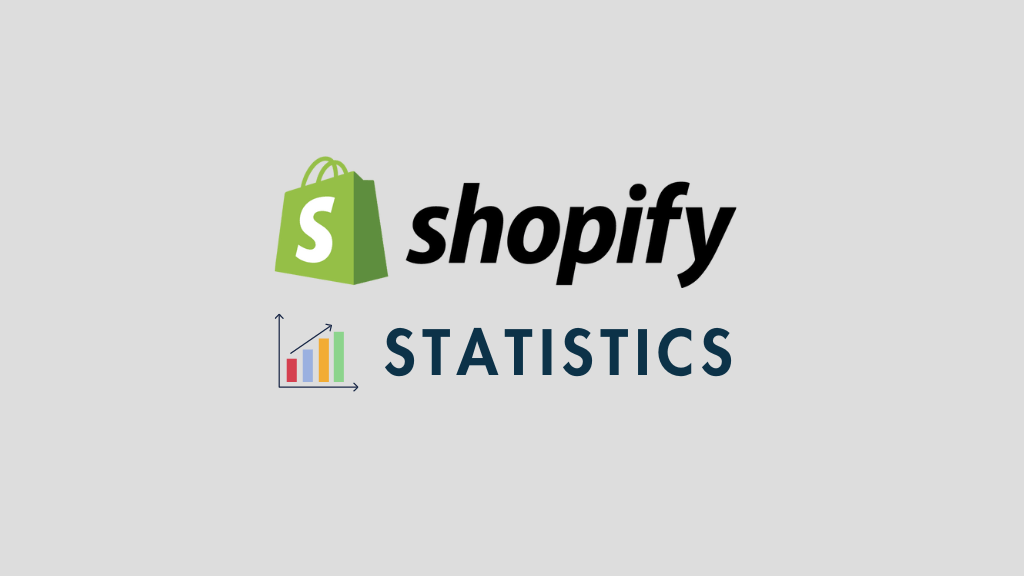
In this Shopify statistics overview, you’ll find all the key facts about one of the best-known ecommerce solutions available. From userbase size and market share to conversion rates and Shopify revenue figures, all the key stats are below…
Please note: you are free to use any of the Shopify stats featured in this post in your own articles. However, we’d politely request that you credit Style Factory as a source and provide a link to this post when doing so. Thank you!
Article highlights
- Some key facts about Shopify
- How does Shopify make money?
- How much does Shopify cost to use?
- Who owns Shopify?
- How many people work for Shopify?
- How many Shopify stores are there?
- Which countries Shopify is popular in?
- Which companies use Shopify?
- What is Shopify’s market share?
- What is the conversion rate for Shopify stores?
- What is the success rate for Shopify stores?
- What is Shopify’s revenue?
- How much is Shopify stock worth?
- How many people use Shopify Plus?
- Interesting facts about Shopify
- Interesting statistics about ecommerce
Some key facts about Shopify
- Shopify is a cloud-based, ‘all-in-one’ ecommerce platform that lets users start an online store. Created in 2006 as a solution for selling snowboarding equipment online, it quickly evolved into an ‘all-in-one’ ecommerce platform catering for online stores of all sizes in a wide mix of industries. (Source: Shopify.)
- Shopify provides online store owners with a set of ecommerce features covering all aspects of running an online business. These include themes; payment gateways (Shopify Payments); point of sale hardware (the Shopify POS system); email marketing tools (Shopify Email); international selling tools (Shopify Markets); tax calculation tools; and shipping solutions.
- Shopify merchants can sell their products on a range of sales channels that includes Facebook, Instagram, eBay, Amazon and TikTok. Additionally, Shopify provides a ‘buy button’ feature that enables the sale of products from a Shopify store on any website or blog (via an embeddable widget).
- Shopify has generated over $1 trillion in sales during its 18+ years of operation — with total revenue of $7.1 billion in 2023 (a 26% increase on the previous year on a constant currency basis). (Source: Shopify.)
- Over 5.54 million ecommerce sites are built with Shopify. (Source: Builtwith.com.)
- Shopify is used by online sellers in over 175 countries around the world, with around 56% of Shopify stores estimated to be based in the US. (Sources: Shopify and Builtwith.com respectively.)
- Shopify’s gross merchandise volume was $235.9 billion in 2023. (Source: Shopify.)
- Shopify possesses 10% of the global ecommerce platform market. (Source: Statista.)
- The average order value on Shopify is $92. (Source: Littledata.io.)
- Prior to laying off around 20% of its workforce in May 2023, Shopify had over 11,600 staff working on the platform. It now has around 8,300+ staff. (Source: Shopify.)
How does Shopify make money?
- Shopify makes money in two ways. First, it charges users a monthly or yearly fee for one of its subscription plans. Second, it charges merchants fees for a large range of optional ecommerce features and services. In Shopify’s financial parlance, these two revenue streams are referred to as ‘subscription solutions’ and ‘merchant solutions’ respectively. (Source: Shopify.)
- Shopify’s revenue from subscriptions makes up around 28% of its overall revenue intake. In the third quarter of 2024 alone, subscription revenue was $610 million — an increase of 25% on the same period in 2023. (Source: Shopify.)
- ‘Merchant solutions’ revenue comes from sales of ecommerce tools and services that include merchant payment services, currency conversion, shipping, point-of-sale hardware / software, business loans, apps, customizable Shopify themes and domain names. (Source: Shopify.)
- Over two thirds of Shopify’s revenue – around 72% of overall revenue – comes from transaction fees, payment processing fees and other merchant services. This revenue stream brought in $1.5 billion in the third quarter of 2024, which constitutes a 26% year over year. (Source: Shopify.)
- Shopify charges theme store developers and app developers 15% of revenue once the developer reaches a threshold of $1 million in Shopify app store sales (Source: Techcrunch.)

How much does Shopify cost to use?
There are 5 Shopify plans available:
- Shopify Starter — $5 per month
- Basic Shopify — $39 per month
- Shopify — $105 per month
- Advanced Shopify — $399 per month
- Shopify Plus — negotiable, but usually starting at around $2,300 per month for a three-year contract.
You can learn more about the features of each of these in our in-depth guide to Shopify pricing or in our YouTube video about Shopify pricing plans.
Who owns Shopify?
- Shopify was launched in June 2006 by 3 founders: Tobias Lütke, Daniel Weinand, and Scott Lake. The trio were driven to build their own ecommerce platform having found existing solutions for their snowboarding equipment business less than satisfactory.
- Skipping ahead 18.5 years to January 2025, Shopify is now a publicly traded company and is owned by its shareholders. Shopify filed for an IPO in April 2015.
- Around 72% of Shopify shareholders are institutional investors like Baillie Gifford and Company (5.2%) and Morgan Stanley (3.4%). In total, 1,736 separate institutions hold Shopify shares and 0.18% of shares are held by company insiders. Shopify’s founder and CEO, Tobias Lütke, currently owns around 6% of the company. (Sources: Yahoo Finance, Wall Street Zen, and Forbes).
- Shopify’s core founder and CEO, Tobias Lütke, whose personal worth is estimated by Forbes to be $9.3 billion, owns over 6% of the company. Significantly, Lütke also enjoys 40% voting power in the company through a non-transferable ‘founder share’ structure agreed by Shopify shareholders at the company’s annual general meeting on 7 June 2022. (Source: Investopedia.)
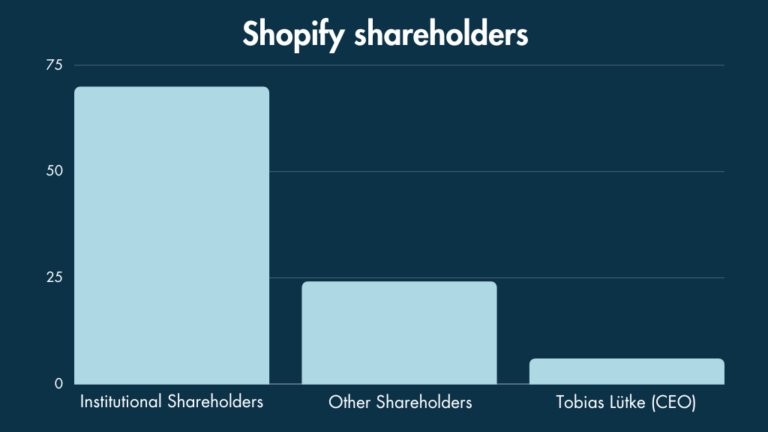
How many people work for Shopify?
- Shopify has upwards of 8,300 employees on its staff in 2024. (Source: Shopify.)
- In addition to staff working directly for the company, over 700,000 app developers, designers and Shopify partners (collectively known as ‘Shopify partners’) make up a Shopify ’employment ecosystem.’ (Source: Shopify President Harley Finkenstein, in a statement at Shopify Unite.)
- Shopify partners and developers have generated $12.5 billion in revenue through businesses and products servicing Shopify sellers. (Source: Shopify).
- It is estimated that 3.6 million jobs have been created by Shopify merchants around the globe. (Source: Shopify.)
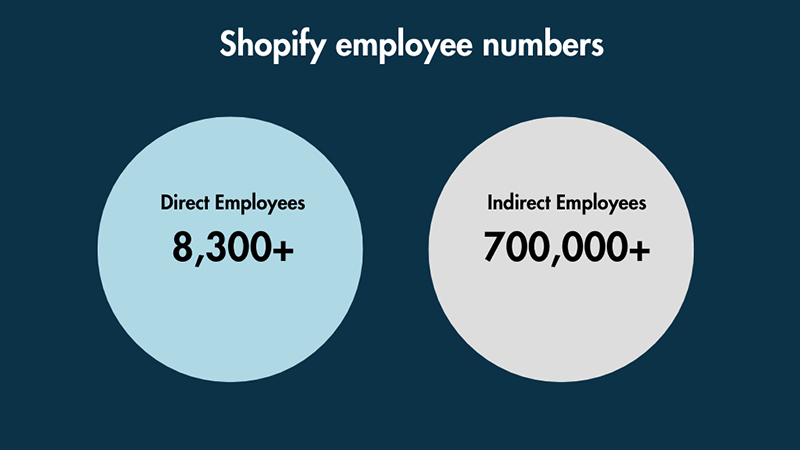
How many Shopify stores are there?
- According to Internet statistics company Builtwith, there are 5,543,760 live websites currently powered by Shopify. (Source: Builtwith).
- Builtwith.com estimates that over course of its 18.5 year existence, more than 9 million online stores have been created on Shopify. (Source: Builtwith.)
- Since 2020, Shopify store numbers have grown by over 200%, with 201.53 per cent growth between March 2020 and January 2022 alone. This percentage increase is a result of more than 2.5 million new Shopify stores being set up in the last two years – the Covid pandemic saw a huge number of traditional ‘offline’ retailers move their business online via Shopify. (Source: Genus AI.)
The below table contains highlights for some key Shopify growth statistics. (Source: Shopify.)
| Year | Number of Shopify users |
|---|---|
| 2012 | 41,000+ |
| 2013 | 84,000+ |
| 2014 | 145,000+ |
| 2015 | 200,000+ |
| 2016 | 377,500+ |
| 2017 | 609,000+ |
| 2018 | 820,000+ |
| 2019 | 1,000,000+ |
| 2020 | 1,749,000+ |
| 2021 | 2,063,000+ |
| 2022 | 4,192,000+ |
| 2023 | 4,889,000+ |
| 2024 | 5,460,000+ |
| 2025 | 5,500,000+ |
Which countries is Shopify popular in?
- Shopify is used by merchants in over 175 countries around the world. (Source: Shopify.)
- Builtwith.com estimates that of the 5.5+ million Shopify stores currently online, 3,143,754 stores are based in the USA — around 57% of all Shopify stores. (Source: Builtwith.com.)
- Shopify’s US stores generated over 10% of all US ecommerce sales in 2021 (Source: The Motley Fool).
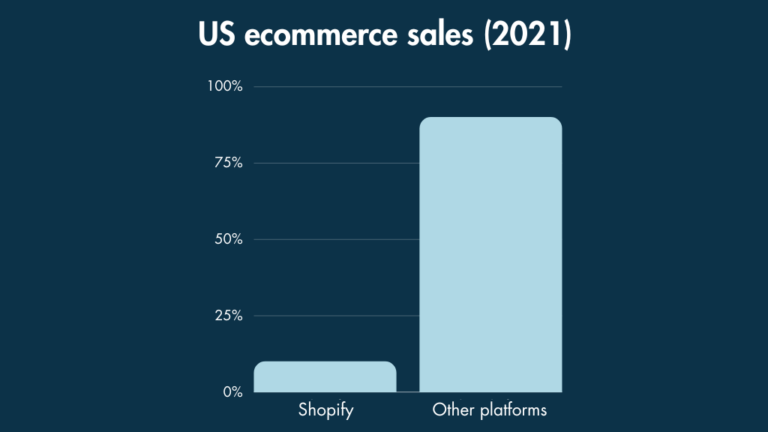
- Shopify’s second largest market is the UK. According to Builtwith.com, there are 220,103 Shopify websites operating in the UK’s $871 billion dollar ecommerce market. (Sources: Builtwith.com and Statista respectively).
- The country with the third most Shopify users is Australia with 156,967 Shopify stores, and Shopify’s fourth most popular market is Germany with 149,697 Shopify stores. Brazil is Shopify’s fifth biggest market with 121,507 Shopify stores based there.(Source: Builtwith).
- Shopify is also popular in its home country of Canada which has 120,157 Shopify stores. (Source: Builtwith.)
- Shopify is used widely across Latin America. In addition to Brazil’s 121K+ Shopify stores, Mexico and Chile have a sizeable number of Shopify merchants too, with 29,522 stores for Mexico and 16,398 stores operating in Chile. (Source: Builtwith).

- 11 of Shopify’s top 20 countries for merchants numbers are located in Europe. (Source: Builtwith.com.)
- While Shopify is extremely popular in English-speaking countries, it is also making ground in the fast-growing Asia-Pacific ecommerce market, thanks to new partnerships with aCommerce in Indonesia, Thailand, and the Philippines. (Source: Techwireasia.com.)
- China is the world’s largest ecommerce market, estimated to be worth $3.3 trillion by 2025 and it is expected that over half of all Chinese retail sales will be online within three years. It is notoriously difficult for western companies to enter the Chinese market, and it’s estimated that Shopify powers just 14,538 stores there. (Source: Shopify and Builtwith respectively).
- Shopify is looking at ways to get access to a larger share of the Chinese ecommerce market, however. In early 2022, it launched a strategic partnership with JD.com, a leading online retailer in China and a key competitor of alibaba.com. This partnership enables some some of Shopify’s US and international businesses commence cross-border ecommerce with Chinese consumers with a 4 week set-up time rather than the standard 12 month period for foreign brands in China. (Source: Shopify.)

Which companies use Shopify?
Shopify is the is the chosen ecommerce solution of companies of all sizes — small fashion boutiques, celebrity brands, global FMCG brands and established household names all use the platform. Well-known companies that use the Shopify platform for online sales include Netflix, Penguin Books and Staples.
Here are some interesting facts on companies and brands using Shopify:
- Kylie and Kriss Jenner have been using Shopify Plus since 2014 to power their popular cosmetics brand Kylie Cosmetics. (Source: Shopify.)
- Celebrity couple David and Victoria Beckham are Shopify customers too. Their companies ‘Eyewear by David Beckham‘ and ‘Victoria Beckham‘ both run on Shopify’s ecommerce infrastructure. (Source: Wemakewebsites.com and Fostr.io respectively)
- Shopify is also the ecommerce platform of choice for British songstress Adele, whose merchandise store is powered by Shopify. (Source: Smartrmail.com.)
- Sports brands such as Gym Shark, the LA Lakers, Decathlon and Fitbit all use Shopify’s platform to sell their product catologs around the globe. (Source: Getbyrd.com.)
- And of course many small businesses use Shopify. Typical examples of these include Style Factory client Little Paper Mill (an artisanal Irish greetings cards provider) and The Cufflink Store (which offers bespoke cufflinks) operate very viable businesses through the platform.
Using data from Yahoo Finance, we’ve put together a list of the largest companies using Shopify (company size is based on market capitalization and market value):
| 1 | Tesla Inc. |
| 2 | LVMH |
| 3 | Nestlé |
| 4 | Pepsi Co Inc |
| 5 | Anhesuer-Bush In Bev |
| 6 | Kraft Heinz Co |
| 7 | Lindt & Spruengli |
| 8 | Whole Foods Market |
| 9 | Red Bull GmbH |
| 10 | Hyatt Hotels Corp |
What is Shopify’s market share?
Shopify is a key player in the ecommerce world. Today’s global ecommerce trade is estimated to be worth 5.5 trillion, and this figure is expected to grow to 7.4 billion by the end of 2025. (Source: Emarketer.com.)
In fact,17.9% of all commerce is ecommerce and this is projected to increase to 24.5% by 2025. (Source: Shopify.)
So, what slice of the ecommerce market pie does Shopify currently possess?
Well, a crucial metric is Shopify’s share of the top one million Internet sites, as these sites are responsible for a disproprtionate amount of ecommerce traffic and trade.
- Shopify is the largest ecommerce platform provider to the top one million sites. It commands a 30% share of the top million ecommerce sites between regular Shopify stores (24%) and Shopify Plus stores (6%). Shopify’s rival, WooCommerce, takes the second spot overall, owning 14% of this lucrative market. (Source: Builtwith.)

- In terms of market share of all ecommerce sites, Shopify ranks fourth with around 10.32% of the global ecommerce market, coming in just behind Squarespace and Woo Themes at 14% and Woocommerce at 38.74%. (Source: Statista.)
- 28% of hosted ecommerce sites in the US are built with Shopify, 11 percentage points ahead of WooCommerce on 23%. (Source: Statista.)
What is the conversion rate for Shopify stores?
The ‘conversion rate’ of an ecommerce platform is calculated by dividing the total number of purchases on the platform by the total number of visitors to the stores built with it.
Ecommerce analysts generally agree that a conversion rate of around 3% is considered a good indicator of a successful online store. If you can convert 3% of your site’s visitors into paying customers, you can build a very viable online business.
So, what’s the conversion rate for stores built with Shopify?
According to ecommerce statistics site Littledata.io…
- The average conversion rate for Shopify stores is estimated to be around 1.4%. This is perhaps unsurprising, considering that 90% of all ecommerce businesses don’t succeed.
- Among the successful Shopify businesses, the top 10% of stores have an average conversion rate of 4.7%, with the highest conversion rate seen on Shopify being 8%.
- The top 20% of Shopify’s 5.5+ million online stores have a conversion rate of more than 3.2%.
- The bottom performing 20% of stores on Shopify have a conversion rate close to 0.4%.
- On mobile devices, the average conversion rate for Shopify stores is 1.2%, although the top 20% of Shopify stores have a mobile conversion rate of 3.9%.
(Source: Littledata.io.)
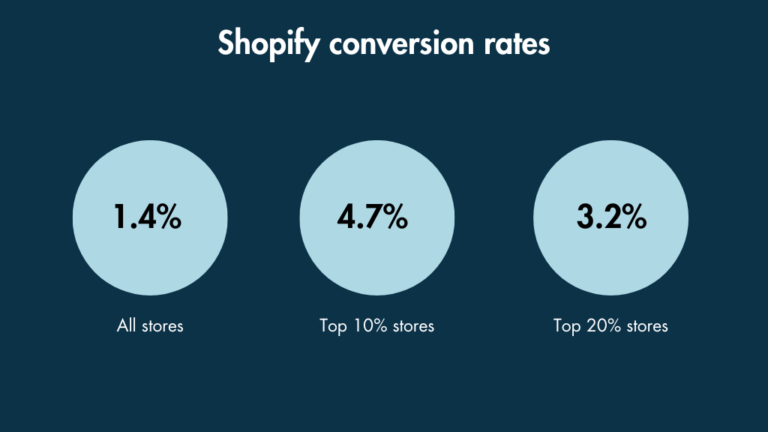
What is the success rate for Shopify stores?
Success rates for ecommerce websites tend to be in the region of 10%. This means that 9 in 10 online shops don’t become successful online businesses. In fact, studies show that most stores fail in the first 120 days of trading online. (Source: Marketing Signals.)
- Shopify stores reflect these trends. The success rates of Shopify stores are thought to be between 5% and 10%, although there are no official company statistics for this. (Source: Internetretailing.net.)
- It’s worth noting that despite Shopify stores following the industry average when it comes to success rates, tens of thousands of Shopify sellers manage to create successful businesses through the platform. Let’s not forget that over $1 trillion worth of sales has been made through the platform over the last 18 years (Source: Shopify.)
Here’s a table of the 10 most successful Shopify stores. (Source: Webinopoly.)
| Rank | Store | Industry |
| 1 | colourpop.com | Cosmetics |
| 2 | jeffreestarcosmetics.com | Cosmetics |
| 3 | fashionnova.com | Fashion |
| 4 | reddressboutique.com | Fashion |
| 5 | gymshark.com | Sportswear |
| 6 | cupshe.com | Fashion |
| 7 | omaze.com | Fundraising |
| 8 | mnml.la | Fashion |
| 9 | yeezysupply.com | Footwear |
| 10 | kith.com | Fashion |
Is Shopify profitable?
It’s necessary to take into account a range of factors such as operating income and net losses when determining a company’s profitability. However, based on several indices, Shopify can be regarded as a profitable company.
- Shopify’s gross profit for 2023 was $3.5 billion, up 25% ($700 million) on 2022. (Source: Shopify.)
- In the third quarter of 2024, gross profit was $1.118 billion, representing a rise of 25% on the same period in the previous year. (Source: Shopify.)
- On the financial markets, Shopify’s profit margin is currently listed as 16.84% and Shopify is running an operating margin of 15.77%. (Source: Yahoo Finance.)
What is Shopify’s current revenue?
- Shopify’s total revenue for 2023 was $7.1 billion, an increase of 26% on 2022. (Source: Shopify.)
- In the third quarter of 2024, Shopify’s total revenue was $2.162 billion. (Source: Shopify.)
- Gross Merchandise Volume (GMV) is the total dollar value of orders facilitated on the Shopify platform, and for the second quarter of 2024, GMV was $69.715 billion — an increase of 24% on the previous year. (Source: Shopify.)
- GMV for 2023 as a whole saw a 20% increase on the previous year to $235.9 billion. (Source: Shopify.)
- Shopify’s Monthly Recurring Revenue (MRR) for the third quarter of 2024 was $175 million, an increase of 28% compared with the previous year. (Source: Shopify.)
- Revenue from Shopify plan subscriptions for the third quarter of 2024 was $610 million, representing an 26% increase year over year. (Source: Shopify.)
- Shopify revenue from its ‘merchant solutions’ income stream (Shopify Payments, Shopify Capital, Shopify Markets) for the third quarter of 2024 was $1.552 billion (a 26% increase year over year). (Source: Shopify.)
Source for the above figures: Shopify.
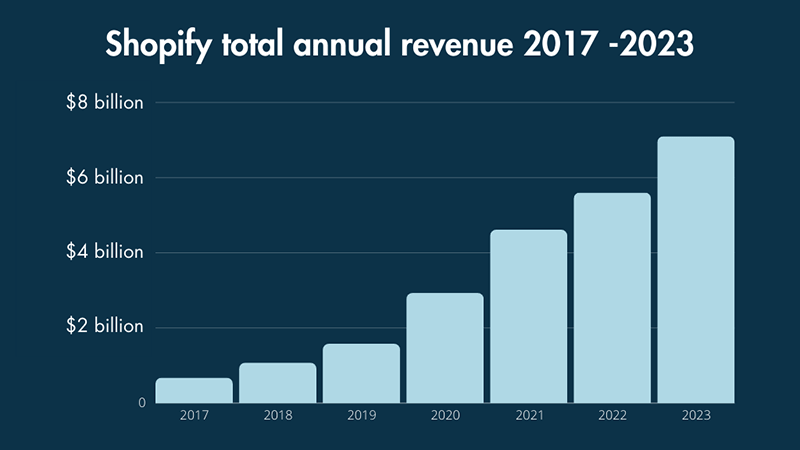
How much is Shopify stock worth?
- Shopify shares are currently valued at around $106.78 per share. (Source: Yahoo Finance.)
- Shopify’s initial public offering (IPO) took place on 20 May 2015, with its stock trading under the name “SHOP” on the New York and Toronto stock exchanges the following day. (Source: Shopify.)
- The IPO closed on 27 May 2015. At time of writing, Shopify ‘s market cap is $84.15 billion. (Source: Shopify.)
- Shopify shares were trading at $1,577 per share back in July 2021 and hit an all-time high around $1,762 in November 2021. (Source: Yahoo Finance.)
- Shopify does not declare or pay cash dividends. Shopify states that “No, we have never declared or paid any dividends and we do not anticipate paying any cash dividends in the foreseeable future. We currently intend to retain future earnings, if any, to finance operations and expand our business.” (Source: Shopify.)

How many people use Shopify Plus?
Shopify Plus is Shopify’s enterprise grade solution for high volume online businesses. Subscription prices for Shopify Plus start at $2,300 per month for a three-year term, or $2,500 for a one-year term.
In addition to all of the core Shopify ecommerce features, Shopify Plus merchants get access to customizable checkouts, additional API calls, unlimited user accounts and advanced apps to enhance their stores.
- According to Internet statistics company Builtwith, there are currently 45,087 Shopify Plus stores in operation, 24,907 of which are based in the US. (Source: Builtwith).
- Shopify Plus stores account for 6% of the top one million internet sites. (Source: Builtwith).
- Shopify’s second-largest market, the UK, has 3,207 Shopify Plus stores (Source: Builtwith).
- Although most of Shopify’s revenue from subscriptions comes from its 4 cheapest plans, merchants on the $2,300+ per month Shopify Plus subscription account account for a fairly sizable 31% of the platform’s monthly recurring revenue. (Source: Shopify.)
How many people use Shopify POS?
- According to Builtwith.com, more than a quarter of a million Shopify sites also use its in-person selling solution, Shopify POS. (Source Builtwith.com)
Shopify POS: merchant data
The “Future Proofing Retail: Embracing Unified Commerce” report by EY (Ernst & Young) examines how businesses are adopting unified commerce strategies. Shopify POS is featured as a key example of a system that integrates online and offline sales channels.
The report is based on data from nearly 4,000 organizations, a survey of over 600 businesses, and interviews with senior retail and digital commerce leaders.
Here are some of the report’s key takeaways on Shopify POS:
- 43% of survey respondents cited a desire for a unified platform as a key factor in their decision to use Shopify POS.
- 85% of mid-market retailers use Shopify POS omnichannel features to drive growth in sales both online and offline.
- Shopify POS users reported an equivalent omnichannel sales growth of +150% quarterly on average year over year.
- Shopify POS has a 20% faster implementation time relative to other POS solutions surveyed.
- Shopify’s POS solution demonstrated a 22% lower total cost of ownership (TCO) on average compared to other market solutions.
- On an aggregate basis, Shopify POS provides an 8.9% equivalent uplift in sales annually for retailers.
(Source: EY)
How much do Shopify merchants make on Black Friday-Cyber Monday?
- Shopify merchants achieved a record $11.5 billion in sales during the 2024 Black Friday-Cyber Monday (BFCM), marking a 24% increase from 2023. (Source: Shopify.)
- Over 76 million consumers worldwide purchased from Shopify-powered brands during the BFCM weekend. (Source: Shopify.)
- Highest sales per minute were recorded at $4.6 million at 12:01 PM EST on November 29. (Source: Shopify.)
- 16% of all Shopify BFCM orders in 2023 orders were cross-border. (Source: Shopify.)
- Over 16,500 entrepreneurs made their first sale on Shopify during this period. (Source: Shopify.)
- More than 67,000 merchants experienced their highest-selling day ever on Shopify.
Source for the above figures: Shopify

How many people use Shopify payments?
- According to Builtwith, around 1.83 million merchants million use Shopify Payments to accept payments on their Shopify stores. (Source: Builtwith.)
- In the third quarter of 2024, the total Gross Merchandise Volume (GMV) processed through Shopify Payments reached $61 billion, compared to $48 billion for third quarter of 2023. (Source: Shopify.)
- Shopify Payments is available in 23 countries. These are:
- Australia
- Austria
- Belgium
- Canada
- Czechia
- Denmark
- Finland
- France
- Germany
- Hong Kong SAR
- Ireland
- Italy
- Japan
- Netherlands
- New Zealand
- Portugal
- Romania
- Singapore
- Spain
- Sweden
- Switzerland
- United Kingdom
- United States
How many Shopify apps are available?
- The Shopify app store features over 13,000 apps.
- Apps relating to ‘marketing and conversion’ are the most popular Shopify apps (2,376), followed by ‘store management’ apps (2,064), ‘store design’ apps (1,886), and ‘orders and shipping’ apps (1,745).
- The most installed app on Shopify is the Facebook & Instagram channel app.
- Here’s the top ten list of the most installed apps on Shopify:
(Source: Shopify app store.)
| Rank | App |
| 1 | Facebook & Instagram |
| 2 | Shopify Email |
| 3 | Google channel |
| 4 | Shopify Point of Sale |
| 5 | Shopify Inbox |
| 6 | Buy Button channel |
| 7 | |
| 8 | DSers‑AliExpress Dropshipping |
| 9 | Geolocation |
| 10 | TikTok |
Shopify acquisitions
Shopify has made several strategic acquisitions of other technology companies in its attempt to maintain and grow its market position. These include the dropshipping company Oberlo, UX agency Jet Cooper and ecommerce recruitment firm Dovetale. (Source: Crunchbase.)
Its most recent large acquisition was its $2.1 billion purchase of logistics company Deliverr. By combining Deliverr with the Shopify Fulfillment Network (SFN), Shopify is hoping to help its merchants compete with Amazon Prime’s next-day delivery service.
“We are confident Deliverr’s ability to simplify the process, and arm merchants with visibility and control from the display of a delivery promise across multiple channels through its completion, will be a huge benefit to our merchants.”
Amy Shapero, Shopify CFO
What are the main alternatives to Shopify?
The ecommerce software market continues to grow, and there is an increasing number of popular ecommerce platforms that are offering stiff competition to Shopify.
WooCommerce is a key Shopify competitor and boasts a similar market share to it. According to Builtwith,
- there are 6,149,588 sites using WooCommerce to facilitate online sales and WooCommerce holds 14% of the top one million websites. (Source: Builtwith.)
- When it comes to the ecommerce platform market as a whole, WooCommerce boasts a 38.74% share of all ecommerce websites. (Source: Statista.)
- WooCommerce has a massive 93% share of the ecommerce ‘plugin’ market, dwarfing the 5% market share of Ecwid, its nearest competitor. Shopify’s ‘Buy Button’ is used by around 20,794 websites. (Source: Builtwith.com)
You can learn more about how WooCommerce stacks up against Shopify in our in-depth comparison of the two platforms.
Another key Shopify alternative is BigCommerce, which boasts a very similar feature set to Shopify. It’s similarly priced, very usable, and it also caters for merchants of all sizes.
- BigCommerce hosts 41,906 live ecommerce websites and has a market share of approximately 0.17% of the top one million hosted websites. (Source: Builtwith.com)
Squarespace is increasingly a direct competitor to Shopify. Although it started life as a traditional ‘website builder’ tool that facilitated the creation of portfolio and brochure sites, in recent years it has introduced ecommerce features, and these are becoming more and more sophisticated.
- Looking at the ecommerce market as a whole, Squarespace has an overall market share of 14.67%, and there are 5,494,572 million live websites built with the platform. However, in terms of the top one million ecommerce sites, Squarespace market share is just 0.3%. (Sources: Statista and Builtwith.com respectively).
Another traditional ‘website builder’ that has in recent years aimed to break into the ecommerce space is Wix. According to Builtwith.com, there are 8,551,029 websites currently powered by Wix; Wix states that over 700,000 of these are online stores.
You can learn lots of other useful facts and stats about Wix in our full ‘Wix statistics’ article here.
What is the gender breakdown of Shopify store owners?
- 52% of Shopify stores are owned by women, whereas 47% of stores are owned by men. (Source: Shopify.)
Other interesting facts about Shopify
- Shopify claims that for every $1 of revenue it makes, merchants using the platform earn $40.82. (Source: Shopify).
- The average order value of online purchases made via Shopify is $85, and the top 20% and 10% of Shopify stores tend to have an average order value of $192 and $311 respectively. (Source: Littledata.io.)
- Checkout completion rates for Shopify stores average out at 45.2% on desktop devices, rising to 58.7% for stores in the top performing 20%. Mobile checkout completions are slightly lower, with an overall average of 44%, and only the top 10% of stores achieving completion rates of 63.9% or higher. (Source: Littledata.io)
- A large majority of Shopify’s 7.1 billion average monthly browsing sessions take place via mobile and 66% of orders on Shopify merchant’s shops are transacted via mobile devices. (Source: Shopify.)
- Shopify has engaged in a wide range of partnerships with sales channels and other ecommerce stakeholders. Some of the most notable partnerships are with JD.com, TikTok, Facebook, Walmart, Alibaba, and Google. (Source: Shopify.)
- Way back in 2004, long before Shopify became the ecommerce behomoth we know today, its first iteration was as a simple online store called ‘Snowdevil’. Once Tobias Lütke developed the code to turn ‘Snowdevil’ into an actual ecommerce platform for hosting other people’s stores, the name was changed to ‘Jaded Pixel’. It wasn’t until two years later in June 2006 that the brand changed its name with the launch of ‘Shopify.’ (Source: Brainstation)
- It only took Tobias Lütke two months to develop the code for the Snowdevil online store. (Source: Signalvnoise.)
- Shopify’s precursor, Snowdevil, was developed with the open source web application framework Ruby on Rails; Shopify’s current template language, ‘Liquid’, is still written in Ruby on Rails and has been in use since 2006. (Source: Github.)
- Of the 175+ countries with active Shopify merchants, there are around 20 countries with just one Shopify store. These include Chad, Vanuatu, Cuba, Fiji, Guam and French Guiana. (Source: Builtwith).
- According to the SEO tool Semrush, approximately 3+ million websites link to Shopify.
Other interesting ecommerce statistics
- Global ecommerce sales are worth approximately 4.9 trillion US dollars. Projections over the next few years are that the ecommerce market will be worth 7.4 trillion dollars by 2025. (Source: Statista.)
- Ecommerce is becoming more and more popular around the world. In 2020 alone, 80% of consumers completed an ecommerce purchase, with almost 90% of consumers in Asia and South America participating in online shopping. (Source: Statista.)
- Ecommerce sales accounted for around 19.5% of total global retail sales in 2023 and this is forecasted to increase to 23% of total retail sales within the next three years. (Source: Statista.)
- In 2021, close to 80% of online shopping orders were not completed. This phenomenon is known as ‘cart abandonment’ in the ecommerce industry. Some sectors, such as the automotive industry, see cart abandonment rates as high as 85.9%. (Source: Statista.)
Recommended reading: check out our full ecommerce statistics resource for a wealth of essential data, facts and graphs on online selling.
Other Shopify resources from Style Factory
I hope you’ve found this rundown of Shopify statistics useful!
For more information on Shopify, be sure to check out our Shopify review, which takes a deep dive into all aspects of Shopify’s feature set for merchants setting up an online store.
For more details on Shopify’s pricing plans, you can refer to our Shopify pricing guide.
If you’d like to try Shopify out for yourself, you can read up on the free Shopify trial here.
If you’re curious about Shopify Plus and how it differs from the other Shopify subscription plans, read our Shopify vs Shopify Plus comparison review here.
And if you’re not sure if Shopify is the best choice for you, you can see how Shopify stacks up against several alternative online retail tools in our Shopify vs Squarespace, BigCommerce vs Shopify, Shopify vs GoDaddy and Wix vs Shopify comparisons.
Finally, if you have any questions on Shopify or Shopify stats, leave us a comment below. We’d love to hear from you.
Other Shopify / ecommerce resources from Style Factory
- BigCommerce vs Shopify
- Shopify vs eBay
- Shopify vs Etsy
- Dropshipping guide
- Ecommerce glossary
- How to start dropshipping with Shopify
- How to start a Shopify store
- How to sell a Shopify Store
- Shopify point of sale pricing guide
- Shopify POS video review
- Wix review
- Wix vs Squarespace
Comments (2)
What an incredible overview!
I’m a developer looking to build a Shopify app as a side project and wanted to get the lay of the land and this exceeded my expectations. Thanks from a fellow Trinity grad.
Chris here, founder of Style Factory (and yet another Trinity graduate). Thanks for the feedback and glad you found this useful Ben!